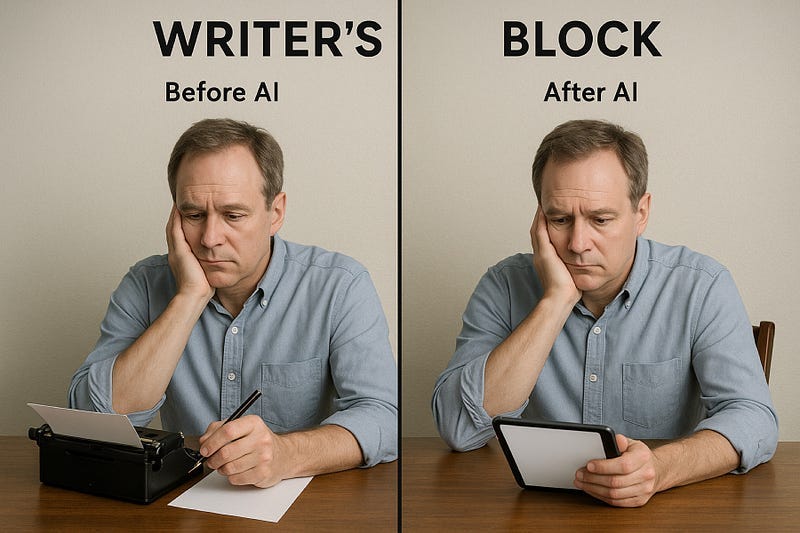The Blank Page Persists: Why AI Suffers Writer’s Block Too
In an age where artificial intelligence can spin out pages of coherent text in milliseconds, assuming the blank page problem is solved is tempting. Just prompt the machine. Just ask. Just delegate. But behind the glossy sheen of generative text lies a quiet irony: AI suffers from writer’s block too, and arguably, even more severely than we do.
Look closely at that image, the man sitting in the same pose “before” and “after” AI. In both panels, he’s stuck. His tools changed: a typewriter became a tablet. But the expression of futility remains. What changed wasn’t the source of creativity. Just the interface. This is the paradox we now live in: tools that write without thinking, and users who believe increasingly they no longer need to.
AI and the Myth of the Infinite First Draft
Let’s call it what it is: infinite draft mode. That’s where AI shines — remixing, repackaging, reformatting. It’s a recursive wizard, a brilliant lateral thinker with zero vertical intent. But here’s the thing: infinite iteration without a north star is drift.
AI doesn’t generate “original ideas” as humans do because it has no stake in the outcome. No motivation. No fear. No itch to scratch. The white page haunts us because it reflects our desire to make meaning. AI, on the other hand, has no desire, only probability. It’s the world’s most elegant echo chamber, and sometimes what it echoes is… nothing — an empty Mirror.
Context Is the New Creativity
This is where the overhyped promise of AI-as-writer collapses. It can complete the sentence. It can continue the story. It can fill the page. But it cannot, on its own, declare what the page should be about.
When humans face a blank page, we confront the full weight of meaning-making. When AI faces one, it waits. Quietly. Endlessly. For us. For the prompt. And here lies the secret: the prompt isn’t just a question. It’s intent. Its structure. It’s context. More often than not, AI is only as creative as humans when asking questions.
That’s why AI without human framing often spins its wheels or spirals into cliché. Because it lacks a stance, it can write “a story about grief in a post-capitalist society,” but it won’t challenge capitalism. It can write a business pitch, but won’t question the business model. It can fake conviction, but it can’t embody it.
The Power of Getting Past Zero
Still, there’s something potent — almost liberating — about moving past zero. AI, for all its limitations, gives us a mirror. A muse. A terrain map, even if it doesn’t choose the destination. The hardest part for writers, founders, educators, and designers is often starting. And if AI can help break inertia, can toss a log on the fire — we’re already ahead.
But here’s the uncomfortable truth for those expecting AI to carry them the whole way: zero plus zero is still zero. And AI is very good at zero without a deeply human pilot.
What Comes Next Is Human
We must learn to wield AI not as the replacement but as the relay — the handoff that happens after intent is forged, after the broader arc is set. Humans still define why, what if, and what matters. And if we forget that, we risk creating more content but less meaning — more noise, less resonance.
So yes, AI can move words across a page faster than any of us. But writing was never about speed. It was always about the signal, which still requires a human hand.
The real writer’s block isn’t the lack of words. It’s the lack of will. And no machine — not now, not ever — can summon that for you.



